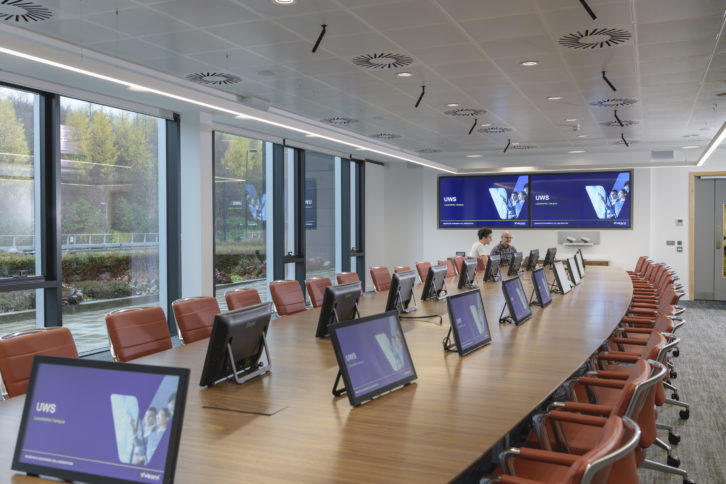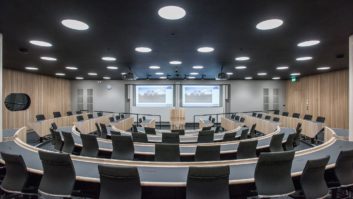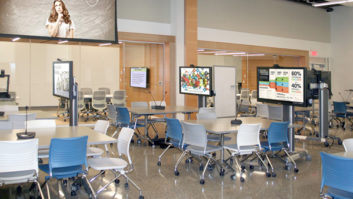
With Generation Z now the primary demographic attending higher education institutions, HE stakeholders have had to adapt to rapidly altering expectations and student requirements. This is a generation that doesn’t recognise a world without the Internet and expects constant connectivity and screen-based, interactive modes of working.
Consequently, in order to attract the best crop of students, universities have had to change quite significantly to ensure that they align with the study expectations of this tech-savvy generation. This has meant more on-the-go learning alongside a huge increase in video-based communications: a digitised campus where screens become a fundamental tool, for students, visitors and staff. Campuses need to be learning environments where communication is ubiquitous and aligned with the habits of millennials.
Universities have discovered in recent years that AV, particularly IP video, is proving to be invaluable for distributing recorded and live-streamed educational material – often accessed from different locations, including different campuses, as well as shared on mobile devices.
Today’s students expect technology to play a key role in their learning experience, such as the ability to charge wirelessly or via USB. They also expect ad hoc collaboration areas and huddle spaces in non-teaching areas. Many universities also encourage students to use established teaching spaces when not formally in use, so similar collaboration tools are introduced into lecture theatres and other teaching areas.
“HE is seeing something of a revolution in teaching methods, with the student acting as agent and the teacher as facilitator”
This more flexible method of learning is becoming the norm, and is set to grow over the next few years, allowing universities to appeal to students away from campuses, with a growth in online courses for remote students and industry professionals.
Of course, distance learning requires AV solutions that allow students and teachers to have a versatile learning environment, with easy-to-use solutions that seamlessly work within existing educational models, rather than disrupting lessons. The learning experience should be more flexible and also enjoyable.
Track and shape
HE is seeing something of a revolution in teaching methods, with the student acting as agent and the teacher as facilitator, with the ability to track and shape a student’s learning journey through collaborative AV technologies.
Mobile learning is also driving the demand for accessing video content and teaching sessions remotely, and this technological transformation enables institutions to archive course curriculums, allowing students to individually tailor their education programmes based on learning interests and teaching modules.
It’s perhaps unsurprising then that video continues to be the most disruptive HE technology, with IP video driving the modernisation of teaching approaches, and interactivity helping to drive the move to more mobile, flexible learning methods. AV tech is helping HE institutions to create cutting-edge digital environments with video at the heart of learning.
Students can respond to lessons via smart devices from a variety of non-traditional locations – either off campus or in breakaway areas away from lecture theatres. IP-driven AV tech is beginning to work in tandem with anywhere, anytime mobile communications connectivity to revolutionise higher education.
By embracing technological advances, institutions are helping students to learn skills faster and in a more user-friendly way. Successful HE AV solutions also need to allow staff to easily connect and operate equipment in a matter of seconds, without any prior technical knowledge.
And while AV-over-IP is already pretty well established across higher education establishments, it is rapidly becoming just part of a wider trend of networked HE tech that is leading to a massive shift in how AV technology is helping to change teaching methods while delivering value to students and the HE institutions – as well as helping universities to add value to their educational spaces by making them available to business to increase revenues.
This is perhaps the pressure point where commercial AV overlaps with HE AV, as one sector bleeds into the other, Indeed, both sectors are being influenced by the other, with commercial organisations keen to keep up with HE institutions in case graduates are turned off by behind-the-curve working environments, and universities concerned that they may lose potential undergraduates to industry. As one sector looks over its shoulder at the other, today’s millennial, Generation Z students and employees are the ultimate beneficiaries – along with everyone involved in AV.







